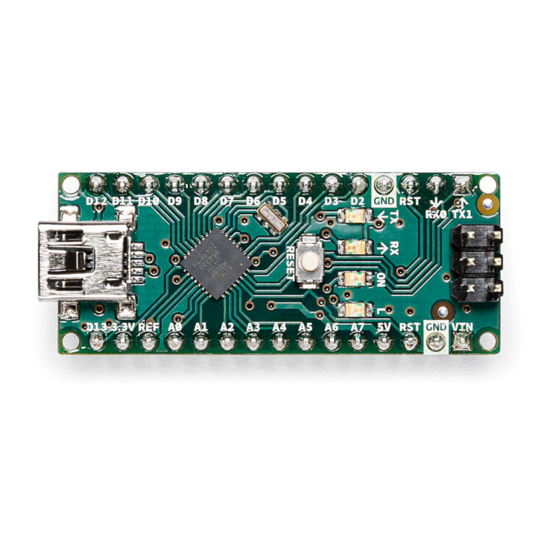
Table of Contents
Advertisement
Quick Links
Arduino® Nano
Product Reference Manual
SKU: A000005
Description
Arduino® Nano is an intelligent development board designed for building faster prototypes with the smallest
dimension. Arduino Nano being the oldest member of the Nano family, provides enough interfaces for your
breadboard-friendly applications. At the heart of the board is ATmega328 microcontroller clocked at a frequency
of 16 MHz featuring more or less the same functionalities as the Arduino Duemilanove. The board offers 22 digital
input/output pins, 8 analog pins, and a mini-USB port.
Target Areas
Maker, Security, Environmental, Robotics and Control Systems
1 / 13
Arduino® Nano
Modified: 29/06/2022
Advertisement
Table of Contents

Subscribe to Our Youtube Channel
Summary of Contents for Arduino Nano A000005
- Page 1 At the heart of the board is ATmega328 microcontroller clocked at a frequency of 16 MHz featuring more or less the same functionalities as the Arduino Duemilanove. The board offers 22 digital input/output pins, 8 analog pins, and a mini-USB port.
- Page 2 Arduino® Nano Features ATmega328 Microcontroller High-performance low-power 8-bit processor Achieve up to 16 MIPS for 16 MHz clock frequency 32 kB of which 2 KB used by bootloader 2 kB internal SRAM 1 kB EEPROM 32 x 8 General Purpose Working Registers...
-
Page 3: Table Of Contents
3 Functional Overview 3.1 Block Diagram 3.2 Processor 3.3 Power Tree 4 Board Operation 4.1 Getting Started - IDE 4.2 Getting Started - Arduino Web Editor 4.3 Sample Sketches 4.4 Online Resources 4.5 Board Recovery 5 Connector Pinouts 5.1 Analog 5.2 Digital... -
Page 4: The Board
Arduino Nano is the first embedded microcontroller in the Nano series with minimum functionalities, designed for mini projects from the maker community. With a large number of input/output pins gives the advantage of utilizing several serial communications like UART, SPI and I2C. The hardware is compatible with Arduino IDE, Arduino CLI and web editor. -
Page 5: Power Consumption
Arduino® Nano 2.2 Power Consumption Symbol Description Unit USB VCC Input supply from USB Input from VIN pad 3 Functional Overview 3.1 Block Diagram Block Diagram of Arduino Nano 5 / 13 Arduino® Nano Modified: 29/06/2022... -
Page 6: Processor
Power Tree of Arduino Nano The Arduino Nano can be powered by either the USB port or alternatively via VIN. The input supply of VIN is regulated by an LDO so the supply is limited to 5V for the optimal functioning of the board. There is also another regulator which limits the voltage to 3.3V for powrering the components with low voltage requirements. -
Page 7: Board Operation
4.5 Board Recovery All Arduino boards have a built-in bootloader which allows flashing the board via USB. In case a sketch locks up the processor and the board is not reachable anymore via USB it is possible to enter bootloader mode by double- tapping the reset button right after power up. -
Page 8: Connector Pinouts
Arduino® Nano 5 Connector Pinouts Power Tree of Arduino Nano 8 / 13 Arduino® Nano Modified: 29/06/2022... -
Page 9: Analog
Arduino® Nano 5.1 Analog Function Type Description +3V3 Power 5V USB Power Analog Analog input 0 /GPIO Analog Analog input 1 /GPIO Analog Analog input 2 /GPIO Analog Analog input 3 /GPIO Analog Analog input 4 /GPIO Analog Analog input 5 /GPIO... -
Page 10: Atmega328
Description Internal Serial Wire Debug Internal Serial Wire Debug Internal Serial Wire Debug Internal Serial Wire Debug Internal Serial Wire Debug Internal Serial Wire Debug 6 Mechanical Information Mechanical dimensions of Arduino Nano 10 / 13 Arduino® Nano Modified: 29/06/2022... -
Page 11: Certifications
7.2 Declaration of Conformity to EU RoHS & REACH 211 01/19/2021 Arduino boards are in compliance with RoHS 2 Directive 2011/65/EU of the European Parliament and RoHS 3 Directive 2015/863/EU of the Council of 4 June 2015 on the restriction of the use of certain hazardous substances in electrical and electronic equipment. -
Page 12: Conflict Minerals Declaration
Arduino® Nano 7.3 Conflict Minerals Declaration As a global supplier of electronic and electrical components, Arduino is aware of our obligations with regards to laws and regulations regarding Conflict Minerals, specifically the Dodd-Frank Wall Street Reform and Consumer Protection Act, Section 1502. Arduino does not directly source or process conflict minerals such as Tin, Tantalum, Tungsten, or Gold. -
Page 13: Company Information
Important: The operating temperature of the EUT can’t exceed 80℃ and shouldn’t be lower than -20℃. Hereby, Arduino S.r.l. declares that this product is in compliance with essential requirements and other relevant provisions of Directive 2014/53/EU. This product is allowed to be used in all EU member states.








Need help?
Do you have a question about the Nano A000005 and is the answer not in the manual?
Questions and answers